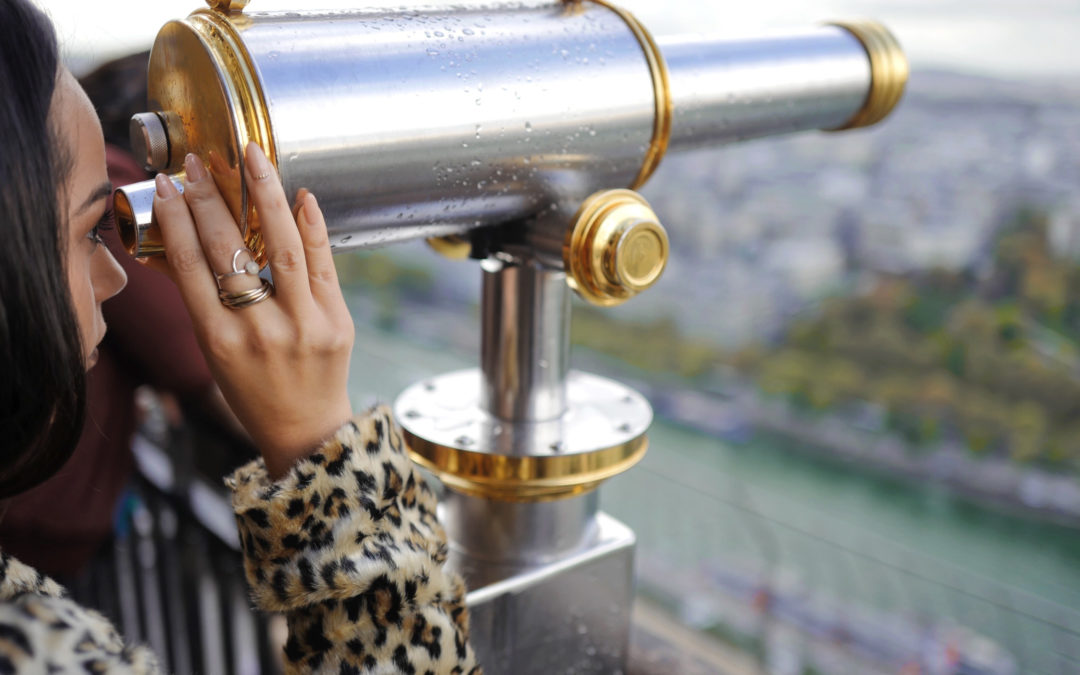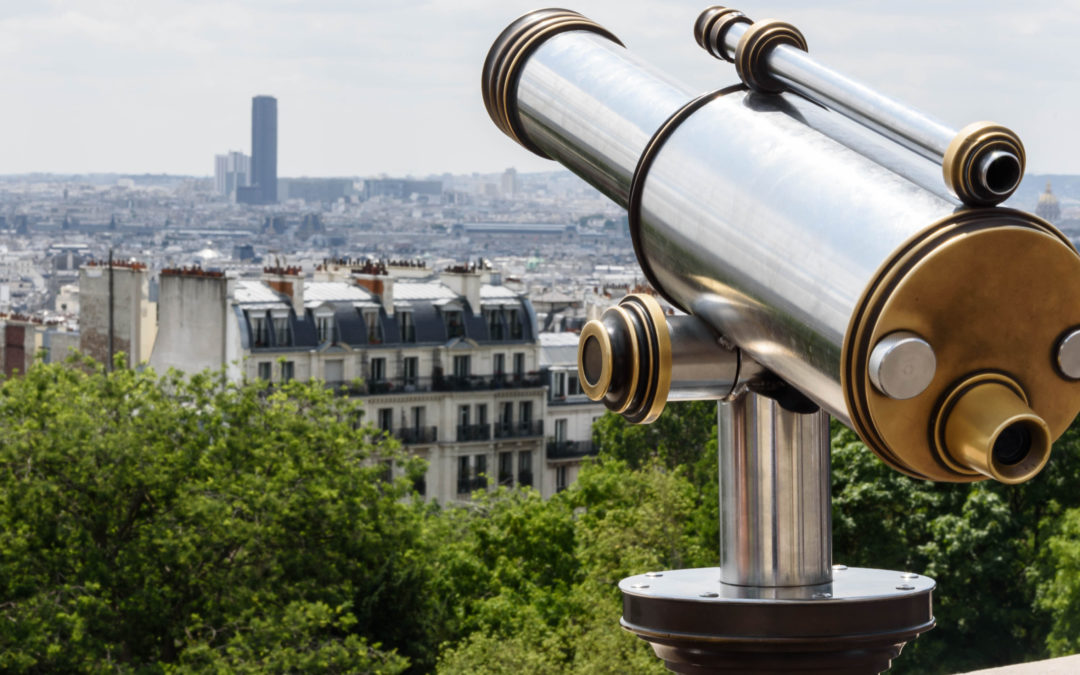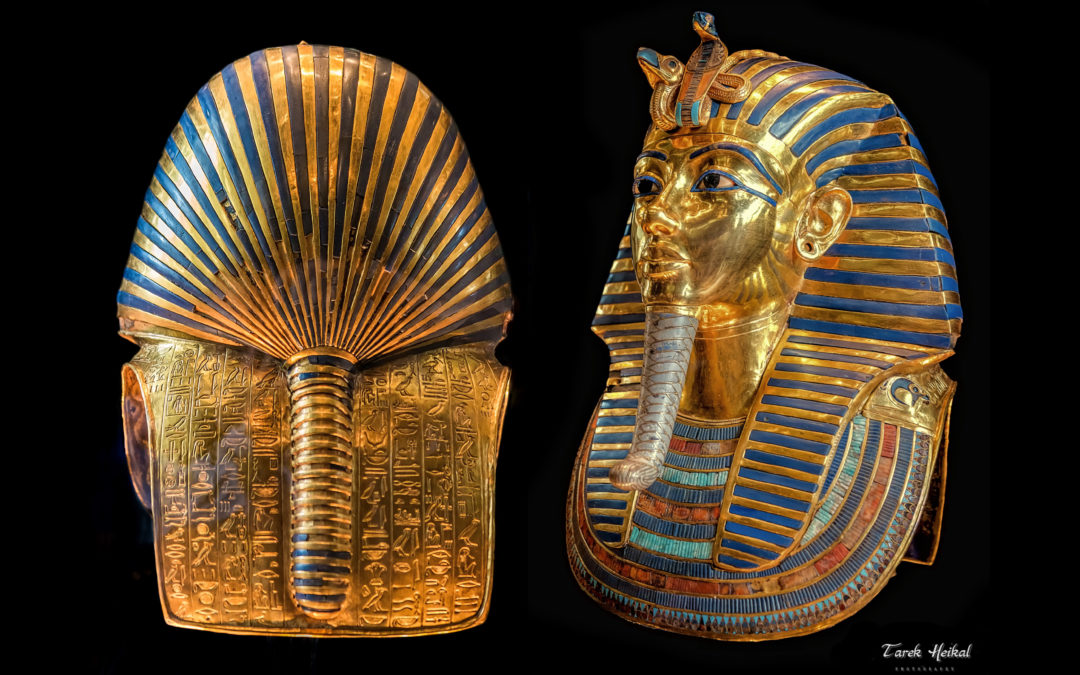
by John | Oct 28, 2017 | Preservation of Purchasing Power, Wealth Protection
The other day I was watching an excellent and classic Japanese film: The Hidden Fortress. This picture stars the inimitable Toshiro Mifune and is directed by Akira Kurosawa. It is about a defeated Samurai clan attempting to smuggle gold across enemy territory to restore the clan’s domain.
I also recently read a Clive Cussler novel: Inca Gold, a mildly diverting story which mixes historical events with legend and fiction. Inca Gold is about a race to discover a hidden cache of gold in South America. While both works are obviously fiction they serve as a reminder of the historical fact that gold has been valued across cultures and across time. One might even say gold is timeless.
Here are a few examples of gold in cultures throughout the world.
A 6,000 year old Gold Pendant

A gold pendant crafted over 6,000 years ago. Photo: via The Daily Mail
The oldest known gold treasure trove is in a Necropolis (burial site, literally “city of the dead”) near the city of Varna in what is now Bulgaria where thousands of gold pieces have been discovered.
One item in the hoard includes a 2 gram 24 karat gold pendant was found thought to date back to 4,300 BC. It is the oldest known gold jewelry.
Other Varna Necropolis gold includes necklaces, bracelets, earrings, a tiara and a gold hammer-scepter.
Source: http://archaeologyinbulgaria.com/2015/10/15/bulgaria-showcases-worlds-oldest-gold-varna-chalcolithic-necropolis-treasure-in-european-parliament-in-brussels/
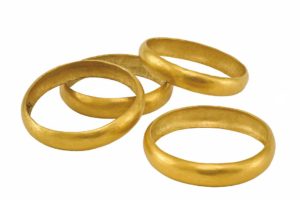
Each of these bracelets weights upwards of 110 grams. These timeless bracelets look like they could have been forged yesterday. (Varna Regional Museum of History)
Source: https://www.smithsonianmag.com/travel/varna-bulgaria-gold-graves-social-hierarchy-prehistoric-archaelogy-smithsonian-journeys-travel-quarterly-180958733/
The Varna Necropolis was rediscovered in 1972. Only about 30% of the site has been excavated. Although I wonder that it might be better to leave the graves, the remains, and the artifacts undisturbed.
Source: http://archaeologyinbulgaria.com/2015/11/20/bulgarias-varna-to-make-site-of-worlds-oldest-gold-varna-chalcolithic-necropolis-accessible-for-tourists/
The 3,300 year Old Gold Death Mask of Tutankhamun
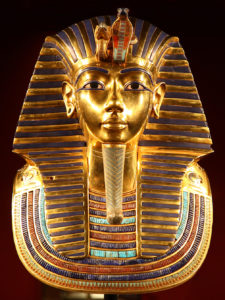
Golden Mask of Tutankhamun in the Egyptian Museum
Tutankhamun was an Egyptian Pharoh (colloquially referred to as “King Tut”). He is famous because his tomb, located in the Valley of the Kings, was found largely intact in 1922. It had been robbed twice in antiquity and resealed. But despite this his tomb is still one of the greatest archaeological finds. The tomb of Tutankhamun contained a veritable trove of artifacts including the iconic solid gold funerary mask pictured to the left.
Source: https://en.wikipedia.org/wiki/KV62
Some of the Egyptian pyramidia were said to have been coated in gold leaf or electrum.
Source: https://en.wikipedia.org/wiki/Pyramidion
Earliest known Gold Coins over 2,500 years old

Early 6th century BC Lydian electrum coin weighing about 4.7 grams
According to greek historian Herodotus the Lydians (a people located in modern day Turkey) were the first to use gold and silver coins somewhere between 700 BC and 550 BC.
At least some of these coins were made from a naturally occurring alloy of gold and silver called electrum and stamped with a lion’s head.
Source: https://en.wikipedia.org/wiki/Lydia#First_coinage
Roman Gold Coins dating back 2,050 years
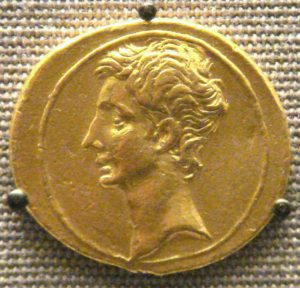
Aureus of Octavian, c. 30 BC.
The roman aureus dates back to the first century BC. Although minted prior to Julius Caesar, Caesar standardized the aureus at a weight of approximately 8 grams of 99% pure gold.
But the history of the aureus, like virtually all government issued money, is one of devaluation.
By the reign of Constantine Solidus, the aureus contained just 4.55 grams of gold.
The latin word for gold is aurum and is the genesis of the periodic table symbol of gold: Au. A derivative of the aurum can also be found in the first name of gold-loving James Bond villain Auric Goldfinger.
Source: https://en.wikipedia.org/wiki/Aureus
Inca and Pre-Columbian Gold
The Inca Empire had considerable gold and silver. However, between 1532-1572 Spanish conquistadors systematically plundered, stole and extorted this wealth as they destroyed the Inca Empire. The cups, necklaces and other gold items crafted by the Incas was melted down, cast into bars and shipped back to Spain.
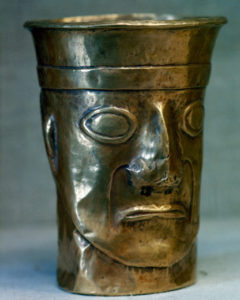
Inca Gold Cup, Picture from National Geographic
A large trove of Inca gold does remain, at least in a legend. Like many others the legend of the lost Inca gold begins in historical fact.
In 1533 the war of succession between two Inca princes had ended. The younger prince Atahualpa defeated his half-brother Huáscar to become Sapa Inca (emperor). Emperor Atahualpa met with Spanish conquistador Francisco Pizarro. Despite being vastly outnumbered Pizarro and his 150 some troops were able to capture the Inca ruler.
Commander Pizarro agreed to release Atahualpa in return for a roomful of gold. This gold was indeed delivered, but Pizarro reneged on the deal and after a show trial had Atahualpa garroted. At this point the line between history and legend blurs.
Legend purports Pizarro had the Inca leader put to death before the last and largest part of the ransom had been delivered. Upon learning their Emperor was killed, the Incas buried the remaining gold in a secret mountain cave. This cave has never been discovered.
Source: https://en.wikipedia.org/wiki/Spanish_conquest_of_the_Inca_Empire
Source: https://www.nationalgeographic.com/archaeology-and-history/archaeology/lost-inca-gold/

Chavín Gold Crown 1200-300 BC
There were of course many other pre-Columbian civilizations apart from the Incas. One is the Chavín culture–an extinct civilization that was located in what is now the northern Andean highlands of Peru. Their achievements included advances in metallurgy, as evidenced by the gold crown shown to the right which could be over 3,000 years old.
Source: https://en.wikipedia.org/wiki/Chav%C3%ADn_culture
Gold Coins of Feudal Japan
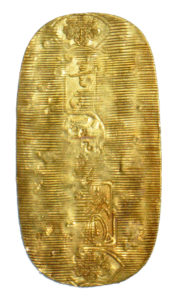
The koban (小判) was a Japanese oval gold coin in Edo period (1603–1868) feudal Japan. Shown here is the Keichō-period koban containing 16.5 grams of gold.
Shogun Tokugawa Ieyasu established a metallic monetary system in 1601 which would last until 1867.
Source: https://en.wikipedia.org/wiki/Tokugawa_coinage
One of the units in the Tokugawa monetary system was the koban (小判) which means oval. When first introduced it contained 1 ryō of gold or about 16.5 grams and was considered to be a rough equivalent to four koku (石) of rice.
Source: https://en.wikipedia.org/wiki/Ry%C5%8D
One koku of rice was originally defined as the amount of rice needed to feed one person for one year. This original definition of a koku of rice would weigh about 150 kilograms (330 pounds). Thus one koban would be worth around 4 years of sustenance.
Source: https://en.wikipedia.org/wiki/Koku
Although in reality the amount of rice that could be obtained, even with a Keichō-period koban certainly would have fluctuated based on the size of the rice harvest, demand and various other factors, it still serves as an insight into the value of the koban when first introduced.
Like all nearly all governmental systems of money, it was steadily devalued as shown visually with the decreasing size of the koban over the years.

Koban debasement
Gold is Timeless
Gold has been valued across the ages and across cultures. In the spirit of modern hubris commentators have declared gold a barbarous relic and a pet rock. Some folks might concede that gold was once useful, but now that we have computers and electricity and bitcoin we don’t need gold. It takes a unique pride or perhaps outright ignorance to make such a pronouncement about an element that has been valued for millennia.
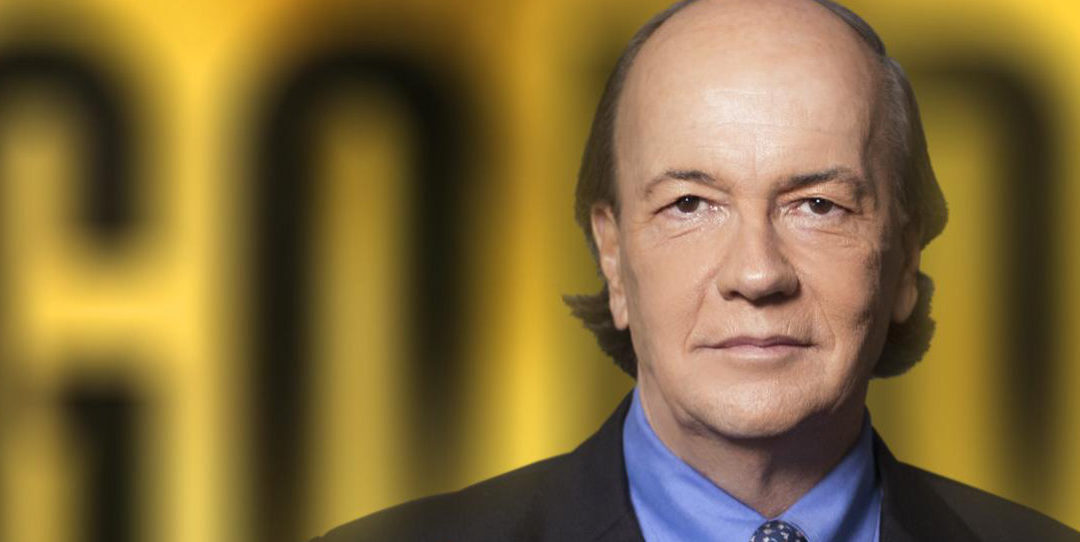
by John | Aug 30, 2017 | Capital Appreciation, Currencies, Geopolitical Risk Protection, Preservation of Purchasing Power
Whatever vestigial link between US dollars and gold ended after Bretton Woods was terminated on 15 August 1971. The classic gold standard was abolished long before in 1933 when the despotic executive order of United States President Franklin D. Roosevelt that made it illegal for citizens in the land of the free to own gold.
There are periodic calls to return to a gold standard as a way to reign in government spending. The return to a pre-1933 gold standard would be a huge step in the right direction.
A true gold standard uses gold as money. A true gold standard in the US would redefine dollars as a quantity of gold. A true gold standard is NOT saying that gold is worth $35 per ounce as was the case in Bretton Woods.
This is explained in fantastic detail by Mises Institute Senior Fellow Joseph T. Salerno in his lecture Gold Standards: True and False.
A Return to the Gold Standard in the US?
It sounds click-baity to me too, but Jim Rickards is predicting $10,000 gold as the result of a currency reboot. The link above is to a sales page (which I get zero benefit from and considered not linking to) that explains in his own words why Rickards thinks Trump will return the US to a “gold standard”.
James G. Rickards is a New York Times bestselling author who appears on networks like RT, CNBC and Bloomberg. He’s testified in front of congress, he’s done some consulting on currency for the CIA and Pentagon. So there are some reasons to listen to what he says and at least evaluate his rationale and his arguments.
If I can quickly summarize his argument it’s that the US is deeply in debt, debt has crushed the middle class, a gold standard is one of the keys to “Making America Great Again” and so President Trump going to move the US back onto a gold standard. Rickards also claims he has some inside information that gives him additional reason to believe a return to such a gold standard is likely.
I agree the US is deeply in debt. I also agree the economy is broken and stacked against the middle class in favor of the super-wealthy. I also agree that a return to a classic gold standard similar to what existed pre-1933 would help America.
There is also some evidence that Trump is receptive to the gold standard.
Would Trump Support a Gold Standard?
Trump has stated to GQ: “Bringing back the gold standard would be very hard to do, but boy would it be wonderful. We’d have a standard on which to base our money.” In the same montage of questions he also stated that Justin Bieber shouldn’t be deported and that he’s not a fan of Man Buns.
Trump has also tweeted this:
Although “gold” here could simply mean wealth.
As far as I can tell Donald Trump is not a systematic thinker. He doesn’t have a set of principles with which he evaluates problems and situations. I think Trump’s “philosophy” is basically “I’m a smart guy with good business sense. So I’m going to use my gut and my experience to make ad hoc judgments about what to do.”
Although he probably wouldn’t use the term ad hoc.
So could Trump be in favor of a gold standard? Who knows? Even if he was in some way at some point in the past who knows what he would decide today. Just look at his 180 turn on the war in Afghanistan as one example of his fickleness.
Where does Rickards get $10,000?
Rickards uses a fairly basic calculation based on what he thinks the world money supply will be, how much gold there is and a 40% backing to get $10,000 gold.
Rickards writes that the US government would keep the price at this level by simply conducting some “open market operations” in gold:
The Federal Reserve will be a gold buyer if the price hits $9,950 per ounce or less and a gold seller if the price hits $10,050 per ounce or higher
And this is really the rub. Such a price peg is not a return to a true gold standard. It would not change the US government’s fiat monetary system in any meaningful way.
Dollar to Gold Price Pegs are not a True Gold Standard
The plan Rickards describes is essentially the same as a bill that was proposed in 2013. Mises Institute fellow Joseph T. Salerno explains how such a fake gold standard would not help at all. A true gold standard defines dollars (or other currency) as a certain weight of gold. For example, the definition of a dollar used to be 1/20th of an ounce of gold (roughly). A $20 bill was not the money per se but a claim to one ounce of gold.
The “gold standard” Rickards speaks of is simply fixing the price of gold in dollars.
I Would Like Gold at $10,000
All else equal I would like gold at $10,000. Sure, if I wanted to add to my holdings it would be cost prohibitive, but since I already own some gold a price increase to $10,000 via Federal Reserve open market operations would be of benefit to me.
However, if the dollar collapsed and a loaf of bread costs $10,000 I’m probably not better off. After all no sane person would want to be a millionaire in Zimbabwean dollars in 2008.
This fake gold standard Rickards is predicting certainly wouldn’t help the US economy at large. As I mentioned above, it would not be any significant change to the fiat monetary system. A price peg of gold in terms of dollars is NOT a gold standard. If anything I think it would be horrible optics for the US government and shake the world’s confidence in the dollar. It would effectively be a revaluation down of the dollar, at least relative to gold, and the Fed’s balance would very likely have to massively expand in order to bid gold up to $10,000.
A Return to the Gold Standard Seems Unlikely
A return of the United States to a true gold standard seems very unlikely. A fake gold standard as described by Rickards is more likely than a return to a true gold standard–but still a long shot. I do believe gold is a fantastic long term investment but I also believe it will take the market waking up to the problems of the global financial system and not an act of government.

by John | Aug 21, 2017 | Preservation of Purchasing Power, Wealth Protection
Gold recently traded above $1,300 per troy ounce for the first time time in 2017. It immediately fell back down to the mid $1,280s. This is the third time the price of gold has been beaten back down when attempting to breakout above $1,300.

Price Resistance at $1,295 continues to hold.
In April of this year I made some “predictive guesses” as to the price of gold. Thus far gold has traded around the purple dotted line that I anticipate will be the general price of the yellow metal.
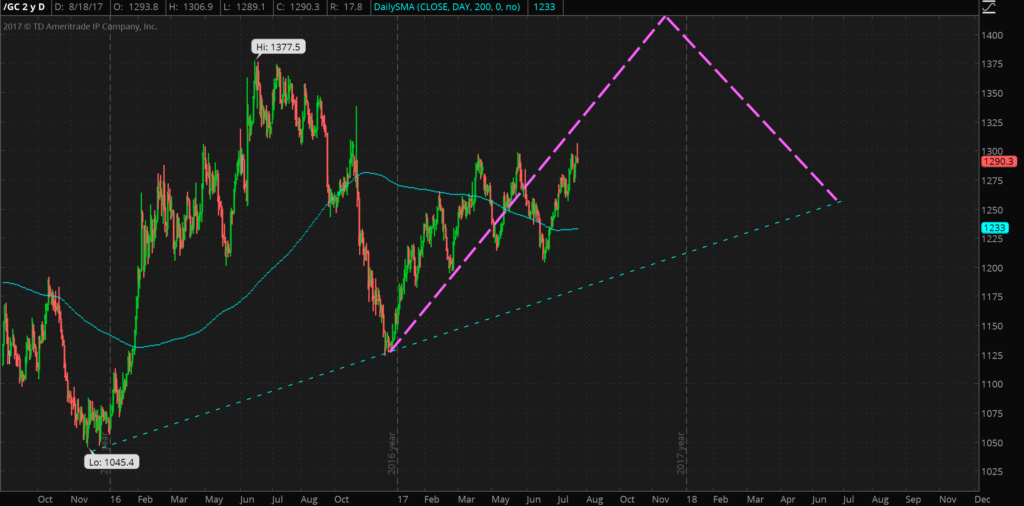
The purple line is my predictive guess as to the price of gold, made in April of 2017.
My predictive guess calls for gold to trade up to $1,400 in November before tailing off again. I expect gold to continue to trend slowly upward in the long term, until there is some large external catalyst such as a stock market crash, physical supply shortage, war or currency crisis, that propels the price upward.
I think holding some gold in one’s physical possession is wise, it’s also important to hold some offshore out of one’s home jurisdiction. While I only hold a portion of my assets in physical gold and silver I think it’s an important component of a diversified portfolio.
Click here to learn about one of my favorite ways to own physical gold.
